Kepler for the Masses: Nvidia GeForce GTX 660 Ti from Zotac Review

Graphics cards based on Nvidia’s top GK104 “Kepler” graphics processor become more and more affordable. We have just recently talked about GeForce GTX 670, but time has already come to meet a new kid on the block – GeForce GTX 660 Ti!
It’s been less than three months since the GeForce GTX 670 release but Nvidia has already prepared another new product. It is the highly anticipated GeForce GTX 660 Ti. Huge hopes are laid on this product because it is targeted at the popular mainstream market segment where AMD’s Radeon HD 78xx series (and the cheapening Radeon HD 7950) have entrenched themselves. The GeForce GTX 660 Ti faces a daunting task indeed as there are a lot of high-speed Radeon HD 7870 GHz Edition cards selling at highly attractive prices. Well, Nvidia’s partners are no sluggards, either. We are going to carry out our first test session not with a reference GeForce GTX 660 Ti, as is usually the case, but with a serial product from Zotac.
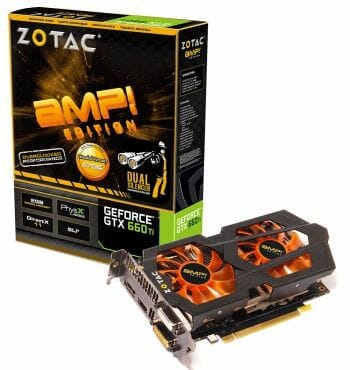
The rest of Nvidia’s partners, including ASUS, EVGA, Gigabyte, Galaxy, MSI and others, have also come up with their own versions of GeForce GTX 660 Ti. Hopefully, we’ll have a chance to test them as well, but now please welcome the Zotac GeForce GTX 660 Ti 2GB!
Closer Look at Zotac GeForce GTX 660 Ti 2 GB Graphics Card
Technical Specifications and Market Positioning
The table below compares side by side the reference Nvidia GeForce GTX 670 against the reference Nvidia GeForce GTX 660 Ti. We are going to dwell on the distinguishing features of the specific Zotac product reviewed today late in this article:
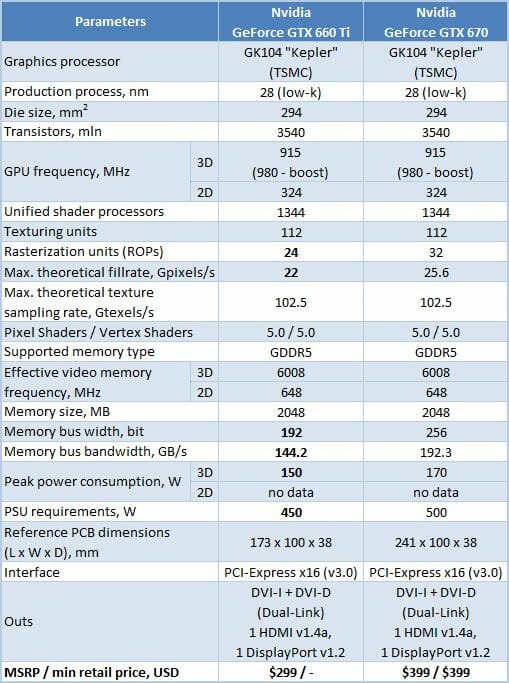
The GPU of the GeForce GTX 660 Ti is in fact a copy of the GTX 670’s GPU with one disabled rasterization cluster, so the total number of raster operators is 24 instead of 32. The memory bus is reduced in width from 256 to 192 bits, so the peak memory bandwidth is 144.2 rather than 192.3 GB/s. The number of texture-mapping units and unified shader processors has remained intact. The cut-down bus and rasterization section help lower the power requirements. The GeForce GTX 660 Ti is specified to consume 150 watts at peak load and is recommended to be used with a 450-watt power supply. There are no other differences from the GeForce GTX 670 in terms of specifications.
The positioning of the new graphics card is somewhat tricky. The flagship GeForce GTX 680 comes at a recommended price of $499 today. The GeForce GTX 670 is priced at $399, so the GeForce GTX 660 Ti is expectedly priced at $299. We have a logical and linear reduction in price in $100 steps moving from a higher to a lower model. However, it is hard to name the competitor to this card in the AMD camp. After the recent price cut the Radeon HD 7950 is expected to cost $349 and the Radeon HD 7870 GHz Edition, $299. However, AMD has got some advantage in time, having released its current product series much earlier than Nvidia, so the Radeon HD 7870 GHz Edition can already be bought for $269 and the Radeon HD 7950, for its recommended $349. Considering that a new graphics card usually costs more than recommended in its first few months on the market, we can suppose that the GeForce GTX 660 Ti is going to compete with the Radeon HD 7950 for the time being.
Packaging and Accessories
Zotac’s graphics card comes in a large box with an attractive colorful slip-cover:
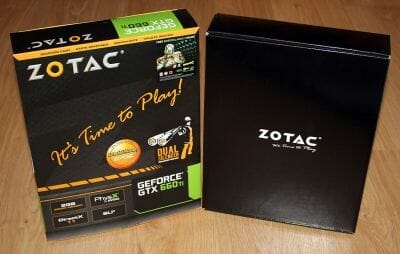
There’s information on the box about the product model, memory amount, key technologies, extended warranty and cooling system. We can also see a Borderlands 2 sticker here.
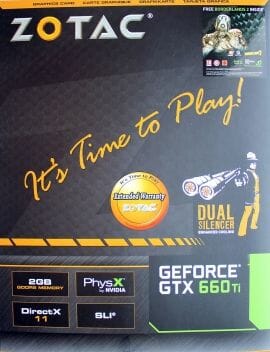
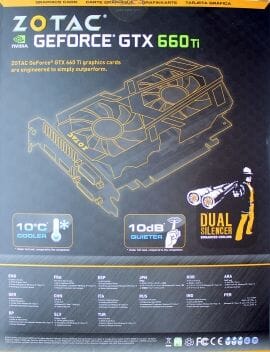
The graphics card is pictured on the back of the box. The icons inform you that the original cooler is 10°C more efficient and 10dB quieter than the reference GeForce GTX 660 Ti cooler.
There’s a foam tray inside the box with compartments for the card and its accessories.
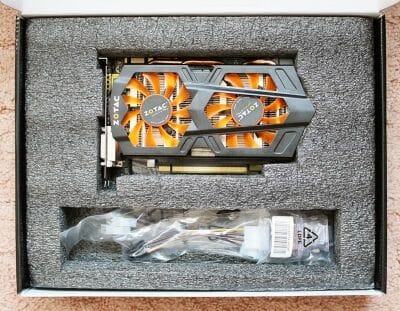
So, the product is protected against any hazards during transportation. That’s important.
Included with the card are two power adapters, a DVI->D-Sub adapter, a CD with drivers, utilities and other software, installation guides, and coupons for downloading TrackMania 2: Canyon and Borderlands 2.
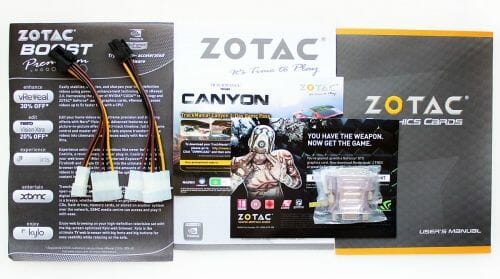
There are no video cables in the box, but otherwise the accessories are even better than what you can get with many higher-class products.
The Zotac GeForce GTX 660 Ti 2GB is manufactured in China and has a recommended retail price of $299. It is shipped with an extended 3-year warranty.
Design and Functionality
The Zotac GeForce GTX 660 Ti 2GB looks very, very small. It must have a record-breaking price/compactness ratio where the former factor is very high and the latter, very low.
The card is only 190 millimeters long, and this with the metallic cooler casing. The PCB itself is a mere 173 millimeters.
Zotac maintains the corporate color scheme in the design of this product where the orange fans are in contrast with the black casing. We can see heat pipes sticking out of the cooler. There are two memory chips residing on the reverse side of the PCB.
Like the senior models of the series (GeForce GTX 680 and 670), the GTX 660 Ti is equipped with DVI-I and DVI-D (Dual-Link), HDMI and DisplayPort outputs. There is a vent grid in the mounting bracket to exhaust the hot air from the cooler.
There are two 6-pin power connectors and two MIO connectors for building SLI configurations. They can be found in their conventional places on the PCB.
The GeForce GTX 660 Ti is specified to consume up to 150 watts of power and is recommended to be used with a 450-watt or higher PSU.
The new card’s PCB is identical to the reference GeForce GTX 670 except for the position of the memory chips.There’s an aluminum heatsink with thermal pad on the power circuit components located between the GPU and the video outputs. The power system formula is 4+2+1 (GPU+memory+PLL).
The GPU voltage regulator is managed by an ON Semiconductor NCP5392P controller located on the reverse side of the PCB.
Everything is exactly like on the reference GeForce GTX 670.
The GPU is the same, too. Our sample is revision A2 and was manufactured in Taiwan on the 18th week of 2012 (late April – early May).
Its base clock rate in 3D mode is 915 MHz (boosted to 980 MHz) at 1.175 volts, which is the same as the clock rate of the GeForce GTX 670. However, the Zotac version is slightly pre-overclocked, to 928 MHz. We can remind you again that the only difference between the GPUs of reference GeForce GTX 660 Ti and GTX 670 cards is the number of raster operators (24 and 32, respectively). The GPU frequency is dropped to 324 MHz at 0.987 volts in 2D mode.
The ASIC quality level of our GPU is 100%.
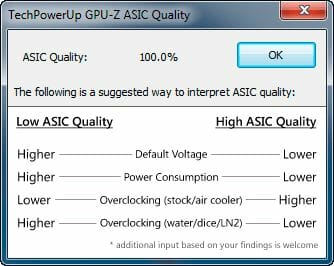
The high quality doesn’t guarantee good overclockability, though.Nvidia’s reference cards are still equipped with memory from Hynix Semiconductor.
The GeForce GTX 660 Ti carries eight memory chips, two of which are on the reverse side of the PCB. There are empty places for more chips, so we can expect 4GB versions of this card to come out as well. The memory is labeled H5GQ2H24AFR R0C, so its rated clock rate is 6000 MHz and that’s indeed the card’s memory frequency. Coupled with the 192-bit bus, the memory bandwidth is 144.2 GB/s.
The latest GPU-Z reports GeForce GTX 660 Ti specs correctly:
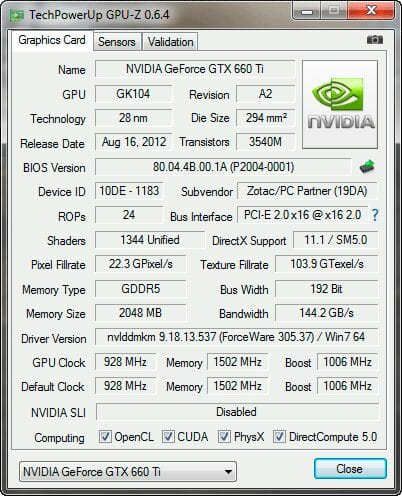
None of popular utilities can work with the BIOS of GeForce GTX 6xx series cards as yet. It would be interesting to write the GTX 670 BIOS into a GTX 660 Ti (they have the same PCBs after all) and see what happens.
Cooling System
Zotac’s Dual Silencer is compact and light.
This cooler consists of a copper base, three 6mm copper heat pipes, an aluminum heatsink, two fans and a figured metallic casing.Removing one of the fans, we can see that the pipes and heatsink ribs are soldered to each other, which should ensure efficient heat transfer.
No soldering can be seen in the cooler’s base, yet the copper base sits firm on the pipes.The whole arrangement is cooled by two Apistek fans.These are 11-blade 80mm fans (part number GA81S2U) whose speed is PWM-regulated from 1000 to 3500 RPM. They seem to run on sleeve bearings. The peak power draw of each fan is 4.6 watts.
We checked out the card’s temperature during five consecutive runs of Aliens vs. Predator (2010) game with the highest image quality settings in 2560×1440 resolution with 16x anisotropic filtering and MSAA 4x antialiasing).
We used MSI Afterburner 2.2.2 and GPU-Z 0.6.3 as monitoring tools. This test was performed inside a closed system case at 25°C room temperature. All thermal tests were carried out before we took the card apart, i.e. with its default thermal interface still intact.
Now let’s see how efficient the Dual Silencer is on the new GeForce GTX 660 Ti card.
With the fans regulated automatically, the GPU was 72°C hot and the fans rotated at 2520 RPM. It’s hard to evaluate the Zotac cooler without knowing anything about the one installed on the reference GeForce GTX 660 Ti, yet the temperature is quite normal for a fast GPU. Interestingly, the GPU had the same temperature of 72°C at the maximum speed of the fans (3450 RPM), too. Our replacing the default thermal grease with Arctic MX-4 didn’t change anything in terms of GPU temperature, either.
Overclocking Potential
We set the Power Limit to the maximum which was 123% for our Zotac GeForce GTX 660 Ti 2GB.
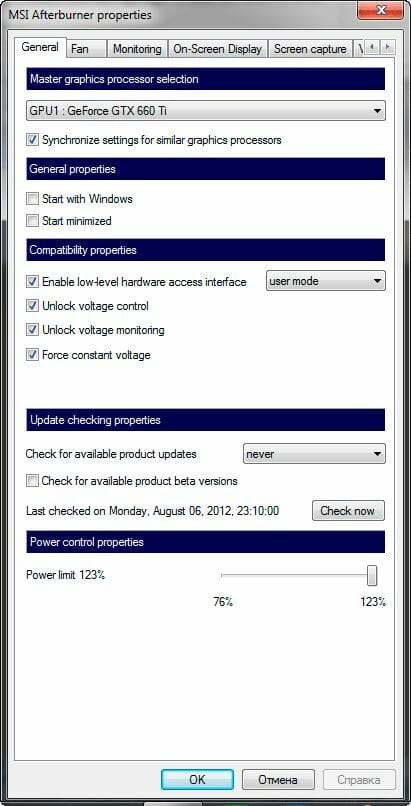
Keeping GPU voltage intact, we overclocked the GPU from its default 928 MHz by 135 MHz. We also overclocked the memory chips by 1160 MHz:
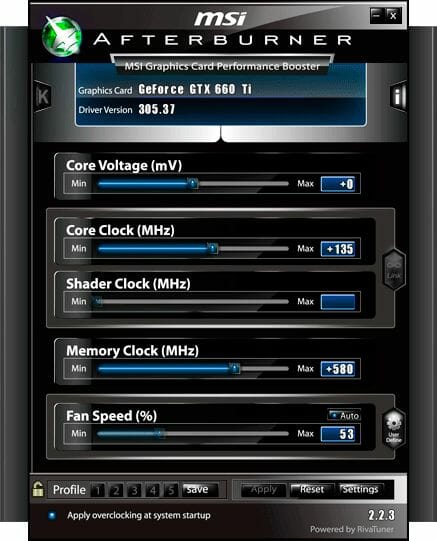
The resulting GPU and memory clock rates were 1063 and 7168 MHz, respectively.
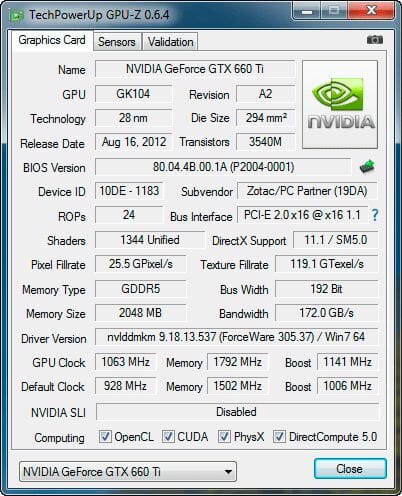
That’s good enough but what about temperature? How hot is the card now?
78°C with the fans working at 2700 RPM. We don’t know how this compares with the reference GeForce GTX 660 Ti and its cooler and we don’t have other brands’ GTX 660 Ti cards as yet. We can only add that we couldn’t reach higher clock rates after increasing GPU voltage.
Noise Level
The noise level of each cooler was measured after 1:00 AM in a closed room about 20 m2 big using CENTER-321 electronic noise meter. The noise level for each cooler was tested outside the system case when the only noise sources in the lab were the cooler and its fan. The noise meter was installed on a tripod and was always at a 150 mm distance from the cooler fan rotor. The tested cooling systems were placed at the edge of the desk on a sheet of polyurethane foam. The lowest noise reading our noise meter device can register is 29.8 dBA and the subjectively comfortable noise level in these testing conditions was around 36 dBA (do not mix it up with low noise level). The fans rotation speeds were adjusted in the entire supported range using our in-house controller by changing the voltage with 0.5 V increment.
We’ve included the results of the reference Nvidia GeForce GTX 670 and AMD Radeon HD 7870 GHz Edition for the sake of comparison. The vertical dotted lines mark the speed of the fans in the automatic regulation mode.
Zotac’s exclusive cooler isn’t much better than the reference cooler installed on the GeForce GTX 670. It is silent in 2D mode but its fans accelerate as soon as you launch a 3D application, becoming audible at 1500 RPM. The noise isn’t irritating even at 2500 RPM, which is the maximum speed of the fans when regulated automatically, but you may prefer some other product if silence is your priority.
Power Consumption
We measured the power consumption of our testbed equipped with different graphics cards using a multifunctional Zalman ZM-MFC3 panel, which can report how much power a computer (without the monitor) draws from a wall outlet. There were two test modes: 2D (editing documents in Microsoft Word or web surfing) and 3D (three runs of Metro 2033: The Last Refuge benchmark in 2560×1440 resolution with maximum image quality settings).
Here are the results:
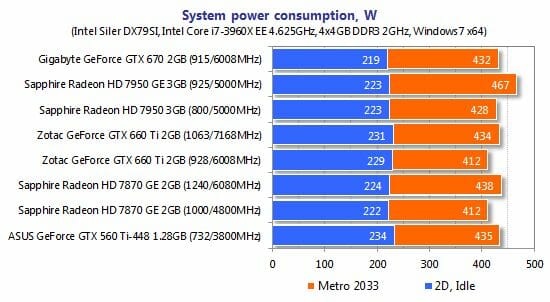
Our configuration consumes about the same amount of power irrespective of the graphics card. The system with the new GeForce GTX 660 Ti needs as much power as the system with the Radeon HD 7870 GHz Edition, also when overclocked. The Radeon HD 7950 GHz Edition is the most voracious, requiring 467 watts. Any of these graphics cards is going to be satisfied with a 500-watt PSU even if the rest of the PC configuration is very advanced.
Testbed Configuration and Testing Methodology
All participating graphics cards were tested in a system with the following configuration:
- Mainboard: Intel Siler DX79SI (Intel X79 Express, LGA 2011, BIOS 0494 from 7/9/2012);
- CPU: Intel Core i7-3960X Extreme Edition, 3.3 GHz, 1.2 V, 6 x 256 KB L2, 15 MB L3 (Sandy Bridge-E, C1, 32 nm);
- CPU cooler: Phanteks PH-TC14PE (2 x 135 mm fans at 900 RPM);
- Thermal interface: ARCTIC MX-4;
- System memory: DDR3 4 x 4GB Mushkin Redline (Spec: 2133 MHz / 9-11-10-28 / 1.65 V);
- Graphics cards:
- ASUS GeForce GTX 560 Ti 448 cores 1.28 GB 256 bit GDDR5, 732/3800 MHz;
- Gigabyte GeForce GTX 670 Ultra Durable 2 GB 256 bit GDDR5, 915/6008 MHz;
- Sapphire Radeon HD 7870 OC Dual-X 2 GB 256 bit GDDR5, 1000/4800 MHz and 1240/6080 MHz;
- Sapphire Radeon HD 7950 OC Dual-X 3 GB 384 bit GDDR5, 800/5000 and 925/5000 MHz;
- Zotac GeForce GTX 660 Ti 2 GB 256 bit GDDR5, 928/6008 MHz and 1063/7168 MHz;
- System drive: Crucial m4 256 GB SSD (SATA-III,CT256M4SSD2, BIOS v0009);
- Drive for programs and games: Western Digital VelociRaptor (300GB, SATA-II, 10000 RPM, 16MB cache, NCQ) inside Scythe Quiet Drive 3.5” HDD silencer and cooler;
- Backup drive: Samsung Ecogreen F4 HD204UI (SATA-II, 2 TB, 5400 RPM, 32 MB, NCQ);
- System case: Antec Twelve Hundred (front panel: three Noiseblocker NB-Multiframe S-Series MF12-S2 fans at 1020 RPM; back panel: two Noiseblocker NB-BlackSilentPRO PL-1 fans at 1020 RPM; top panel: standard 200 mm fan at 400 RPM);
- Control and monitoring panel: Zalman ZM-MFC3;
- Power supply: Xigmatek “No Rules Power” NRP-HC1501 1500 W (with a default 140 mm fan);
- Monitor: 27” Samsung S27A850D (DVI-I, 2560×1440, 60 Hz).
The first competitor to the new GeForce GTX 660 Ti will be GeForce GTX 560 Ti 448 cores from Asus:
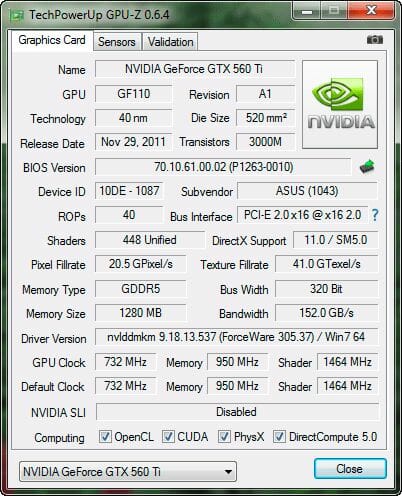
We included it into our today’s test session because we needed to compare the performance of the old and new graphics card generations. It would probably be more correct to use a regular GTX 560 Ti, but unfortunately, we didn’t have one at our disposal at this time.
The second participant of our test session is Gigabyte GeForce GTX 670 Ultra Durable 2 GB:
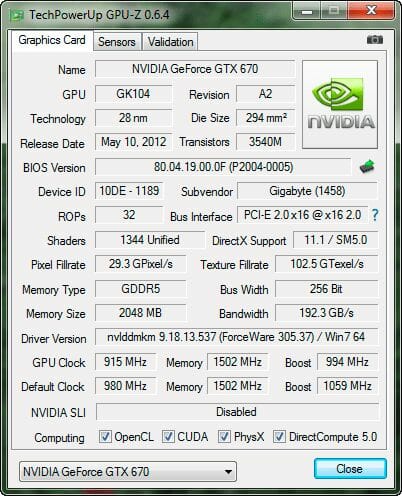
Here the reasoning is very simple: we needed to compare the new GeForce GTX 660 Ti against a GeForce GTX 670 (Gigabyte’s clock frequencies were adjusted to the reference values.
The first competitor from the AMD camp is Sapphire Radeon HD 7870 OC Dual-X 2 GB, which MSRP is currently the same as the recommended retail price of the new GeForce GTX 660 Ti:
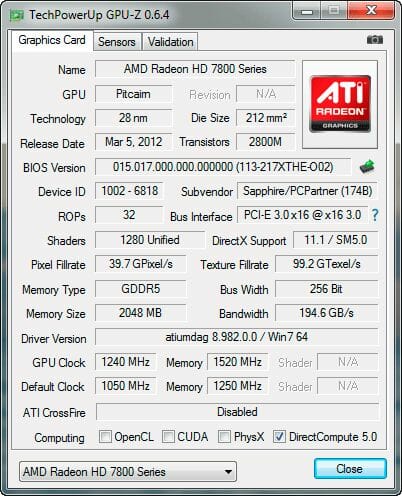
We tested this graphics card at its nominal frequencies of 1000/4800 MHz and overclocked to 1240/6080 MHz (as shown on the screenshot).
The second AMD competitor is Sapphire Radeon HD 7950 OC Dual-X 3 GB:
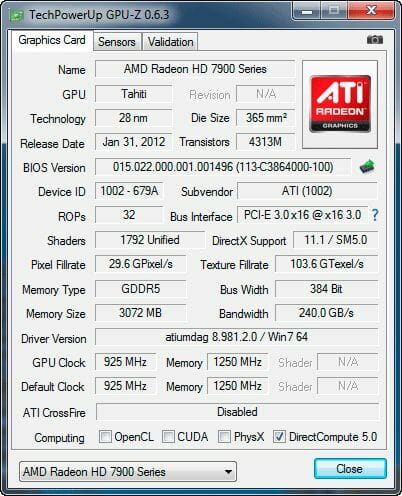
Here I have to point out that right before the launch of the new Nvidia GeForce GTX 660 Ti AMD released a new Radeon HD 7950 BIOS, which allows raising the GPU frequency from 800 to 925 MHz. Nevertheless, we decided to maintain objectivity and tested the Radeon HD 7950 graphics card at both frequencies: the old 800/5000 MHz and new 925/5000 MHz after reflashing the new BIOS into the card.
In order to lower the dependence of the graphics cards performance on the overall platform speed, I overclocked our 32 nm six-core CPU with the multiplier set at 37x, BCLK frequency set at 125 MHz and “Load-Line Calibration” enabled to 4.625 GHz. The processor Vcore was increased to 1.47 V in the mainboard BIOS.
Hyper-Threading technology was enabled. 16 GB of system DDR3 memory worked at 2 GHz frequency with 9-10-10-28 timings and 1.65V voltage.
The test session started on August 10, 2012. All tests were performed in Microsoft Windows 7 Ultimate x64 SP1 with all critical updates as of that date and the following drivers:
- Intel Chipset Drivers 9.3.0.1020 WHQL from 01/26/2012 for the mainboard chipset;
- DirectX End-User Runtimes libraries from November 30, 2010;
- AMD Catalyst 12.x (8.982.0.0 RC1) driver from 07/19/2012 + Catalyst Application Profiles 12.7 (CAP1) for AMD based graphics cards;
- Nvidia GeForce 305.37 beta driver from 07.27.2012 for Nvidia based graphics cards.
We ran our tests in the following two resolutions: 1920×1080 and 2560×1440. The tests were performed in two image quality modes: “Quality+AF16x” – default texturing quality in the drivers with enabled 16x anisotropic filtering and “Quality+ AF16x+MSAA 4(8)x” with enabled 16x anisotropic filtering and full screen 4x or 8x antialiasing if the average framerate was high enough for comfortable gaming experience. We enabled anisotropic filtering and full-screen anti-aliasing from the game settings. If the corresponding options were missing, we changed these settings in the Control Panels of Catalyst and GeForce drivers. We also disabled Vsync there. There were no other changes in the driver settings.
The list of games and applications used in this test session includes two popular semi-synthetic benchmarking suites, one technical demo and 13 games of various genres with all updates installed as of the beginning of the test session date:
- 3DMark Vantage (DirectX 10) – version 1.0.2.1, Performance and Extreme profiles (only basic tests);
- 3DMark 2011 (DirectX 11) – version 1.0.3.0, Performance and Extreme profiles;
- Unigine Heaven Demo (DirectX 11) – version 3.0, maximum graphics quality settings, tessellation at “extreme”, AF16x, 1280×1024 resolution with MSAA and 1920×1080 with MSAA 8x;
- S.T.A.L.K.E.R.: Call of Pripyat (DirectX 11) – version 1.6.02, Enhanced Dynamic DX11 Lighting profile with all parameters manually set at their maximums, we used our custom cop03 demo on the Backwater map;
- Metro 2033: The Last Refuge (DirectX 10/11) – version 1.2, maximum graphics quality settings, official benchmark, “High” image quality settings; tesselation, DOF and MSAA4x disabled; AAA aliasing enabled, two consecutive runs of the “Frontline” scene;
- Just Cause 2 (DirectX 11) – version 1.0.0.2, maximum quality settings, Background Blur and GPU Water Simulation disabled, two consecutive runs of the “Dark Tower” demo;
- Aliens vs. Predator (2010) (DirectX 11) – Texture Quality “Very High”, Shadow Quality “High”, SSAO On, two test runs in each resolution;
- Lost Planet 2 (DirectX 11) – version 1.0, maximum graphics quality settings, motion blur enabled, performance test “B” (average in all three scenes);
- Sid Meier’s Civilization V (DirectX 11) – version 1.0.1.348, maximum graphics quality settings, two runs of the “diplomatic” benchmark including five heaviest scenes;
- Total War: Shogun 2 (DirectX 11) – version 2.0, built in benchmark (Sekigahara battle) at maximum graphics quality settings;
- Crysis 2 (DirectX 11) – version 1.9, we used Adrenaline Crysis 2 Benchmark Tool v.1.0.1.13. BETA with “Ultra High” graphics quality profile and activated HD textures, two runs of a demo recorded on “Times Square” level;
- Hard Reset Demo (DirectX 9) – benchmark built into the demo version with Ultra image quality settings, one test run;
- Batman: Arkham City (DirectX 11) – version 1.2, maximum graphics quality settings, physics disabled, two sequential runs of the benchmark built into the game.
- Battlefield 3 (DirectX 11) – version 1.4, all image quality settings set to “Ultra”, two successive runs of a scripted scene from the beginning of the “Going Hunting” mission 110 seconds long;
- DiRT Showdown (DirectX 11) – version 1.0, built-in benchmark at maximum graphics quality settings (“Ultra” preset) on the “Nevada” track.
- Sniper Elite V2 Benchmark (DirectX 11) – version 1.05, we used Adrenaline Sniper Elite V2 Benchmark Tool v1.0.0.2 BETA with maximum graphics quality settings (“Ultra” profile), Advanced Shadows: HIGH, Ambient Occlusion: ON, Stereo 3D: OFF, two sequential test runs.
If the game allowed recording the minimal fps readings, they were also added to the charts. We ran each game test or benchmark twice and took the best result for the diagrams, but only if the difference between them didn’t exceed 1%. If it did exceed 1%, we ran the tests at least one more time to achieve repeatability of results.
Performance
The results on the diagrams are sorted out according to the recommended retail price of the tested graphics cards (from high to low). Products based on the new generation Nvidia graphics processors are marked with green, AMD products – with red, and Asus GeForce GTX 560 Ti 448 cores – with dark teal colors.
3DMark Vantage
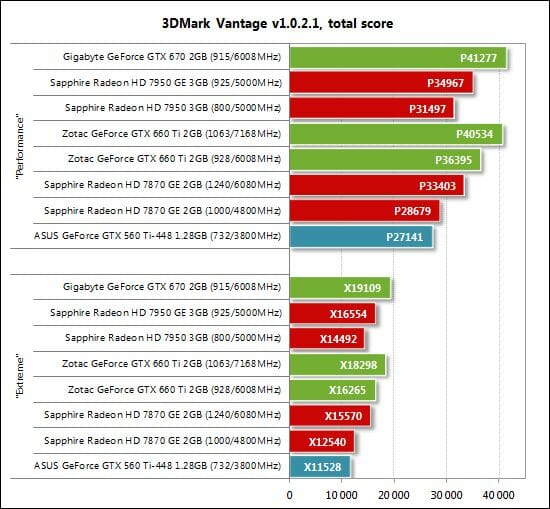
The GeForce GTX 660 Ti looks very confident in our first semi-synthetic benchmark, outperforming all of the AMD-based products at its default clock rates and stopping short of the GeForce GTX 670 when overclocked. The new card is 34-41% ahead of the old GeForce GTX 560 Ti-448. Looks like a very promising start.
3DMark 2011
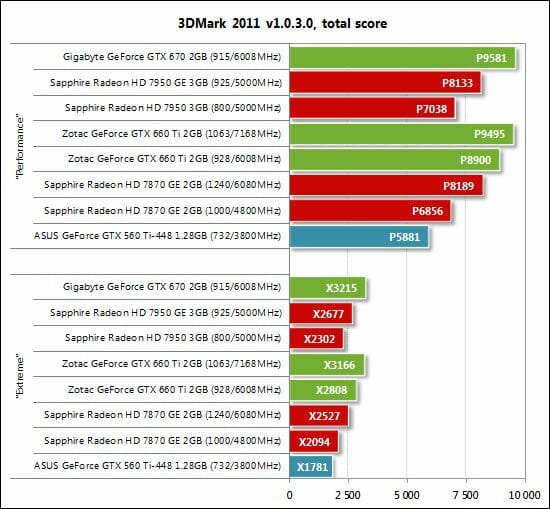
The GeForce GTX 660 Ti performs even better in the newer and heavier 3DMark 2011. At its default clock rates of 928/6008 MHz, the Zotac beats both Radeon HD 7xxx cards, including the HD 7950 with new BIOS. When overclocked to 1063/7168 MHz, the Zotac is almost as fast as the GTX 670. It enjoys an advantage of 51 to 58% over the GeForce GTX 560 Ti-448.
Unigine Heaven Demo
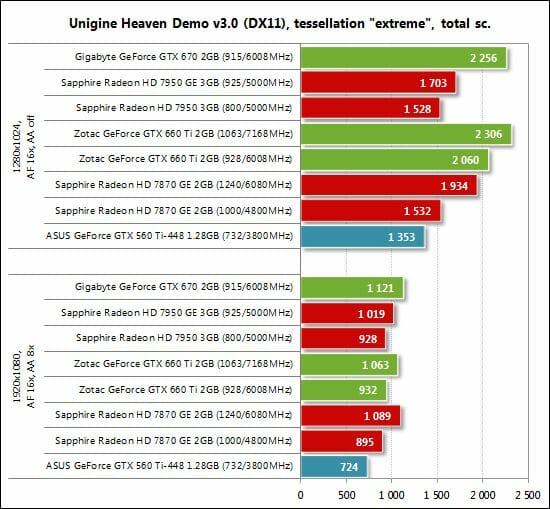
The GeForce GTX 660 Ti is good in Unigine Heaven, especially at the easier settings. It is faster than the Radeon HD 7870 GHz Edition and equal to the reference HD 7950 at 1920×1080 with 8x antialiasing, but the updated HD 7950 with clock rates of 925/5000 MHz is ahead. Interestingly, the slightly overclocked Radeon HD 7870 GHz Edition is somewhat faster than the overclocked GeForce GTX 660 Ti in this test. The latter card must be limited by its memory bus.
S.T.A.L.K.E.R.: Call of Pripyat
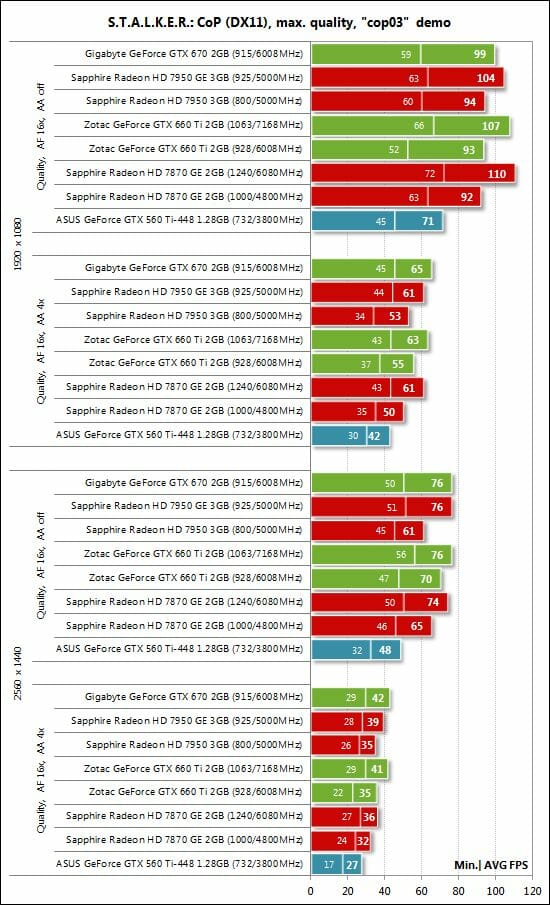
The GeForce GTX 660 Ti is but slightly faster than the Radeon HD 7870 GHz Edition at the default frequencies. The Radeon HD 7950 is harder to beat, especially with the new BIOS. The GTX 660 Ti is also 31-46% ahead of the GTX 560 Ti-448 and 7-28% behind the GTX 670. It easily catches up with the GTX 670 when overclocked, though.
Metro 2033: The Last Refuge
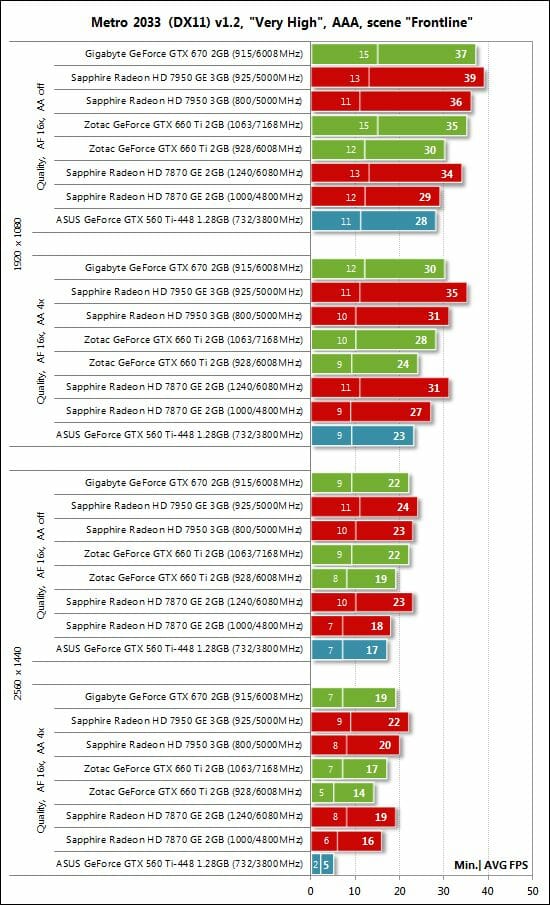
The lack of memory bandwidth can be felt in Metro 2033: The Last Refuge. The Zotac is ahead of the Radeon HD 7870 GHz Edition with MSAA turned off, but the AMD-based card is faster with enabled MSAA. The difference isn’t large, but the frame rates are low, so every frame per second counts. Take note of the colossal advantage of the GeForce GTX 660 Ti over the GTX 560 Ti-448 at the heaviest settings. The old card obviously lacks memory while the newer model’s 2 gigabytes are quite enough.
Just Cause 2
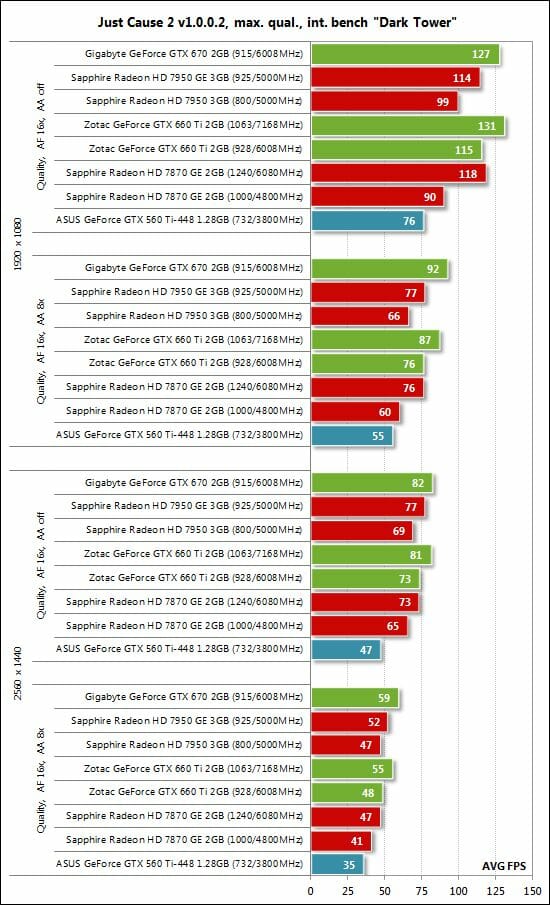
Working at its default clock rates, the GeForce GTX 660 Ti delivers the same performance as the overclocked Radeon HD 7870 GHz Edition or the original Radeon HD 7950. The accelerated version of the latter card is equal to or even slightly faster than the GTX 660 Ti. And this adds points to the new card, of course. It is also 37-55% ahead of the GeForce GTX 560 Ti-448 but fails to catch up with the GeForce GTX 670 even when overclocked.
Aliens vs. Predator (2010)
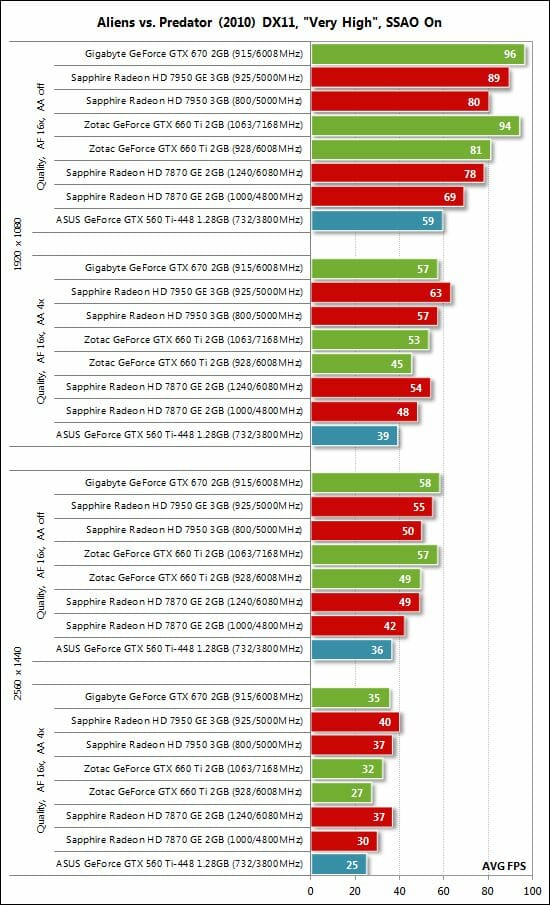
AMD-based products are traditionally fast in Aliens vs. Predator (2010). However, this time around, the Radeon HD 7870 GHz Edition can only win with antialiasing turned on (thanks to the GTX 660 Ti’s 192-bit bus). Without antialiasing, the new Nvidia solution is ahead. The Radeon HD 7950 is even better in both versions, though, but the GTX 660 Ti is 36-37% faster than the GTX 560 Ti-448 and close to the GTX 670 at the default and overclocked frequencies, respectively.
Lost Planet 2
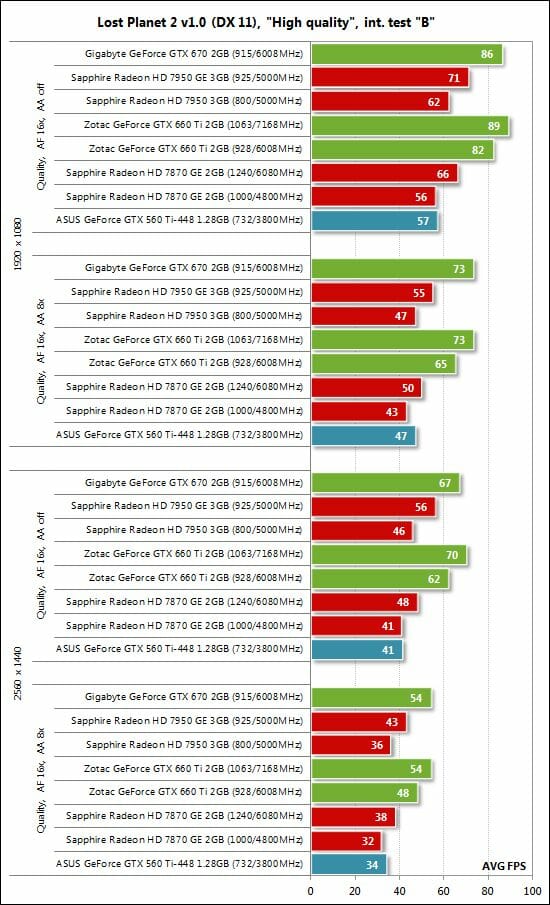
As opposed to Aliens vs. Predator (2010), Lost Planet 2 generally runs better on Nvidia GPUs and this time is no exception. The GeForce GTX 660 Ti is ahead of the Radeon HD 7870 GHz Edition by up to 50% and ahead of the Radeon HD 7950 by 26%. The GeForce GTX 560 Ti-448 is completely outperformed as well. The GeForce GTX 660 Ti even overtakes the GTX 670 when overclocked.
Sid Meier’s Civilization V
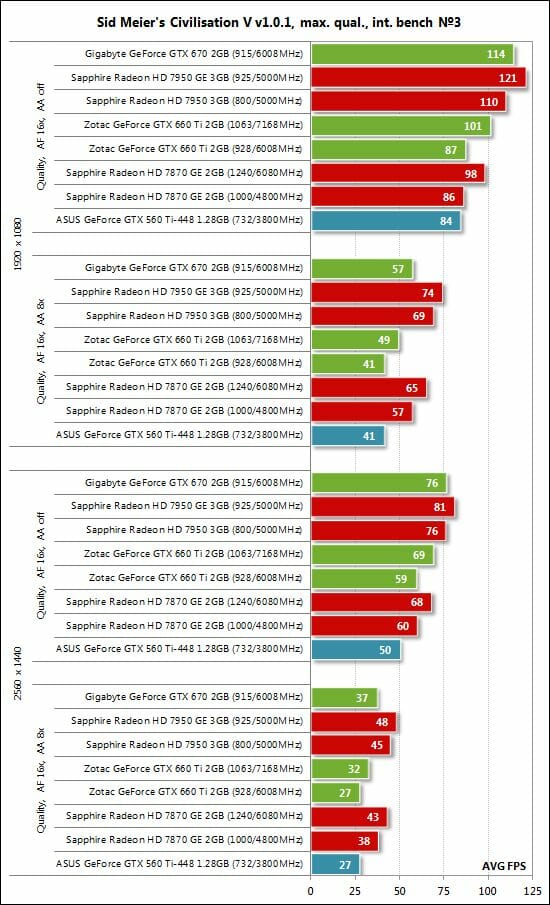
AMD is on top again in Civilization V. The Nvidia-based products find it hard to compete, especially with enabled antialiasing.
Total War: Shogun 2
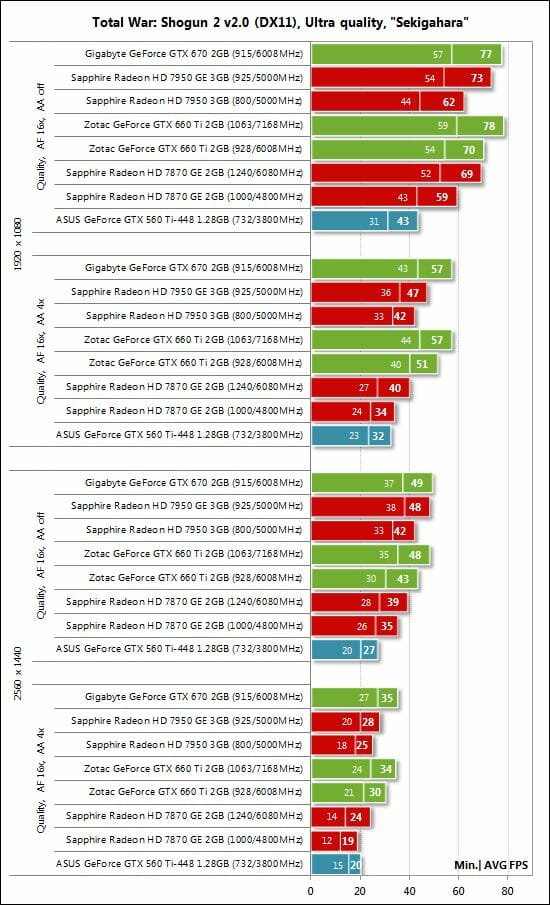
The new driver returns the performance of the GeForce GTX 6xx series in Total War: Shogun 2 to their previously high level, so the GeForce GTX 660 Ti is preferable to both Radeon HD 7870 GHz Edition and Radeon HD 7950.
Crysis 2
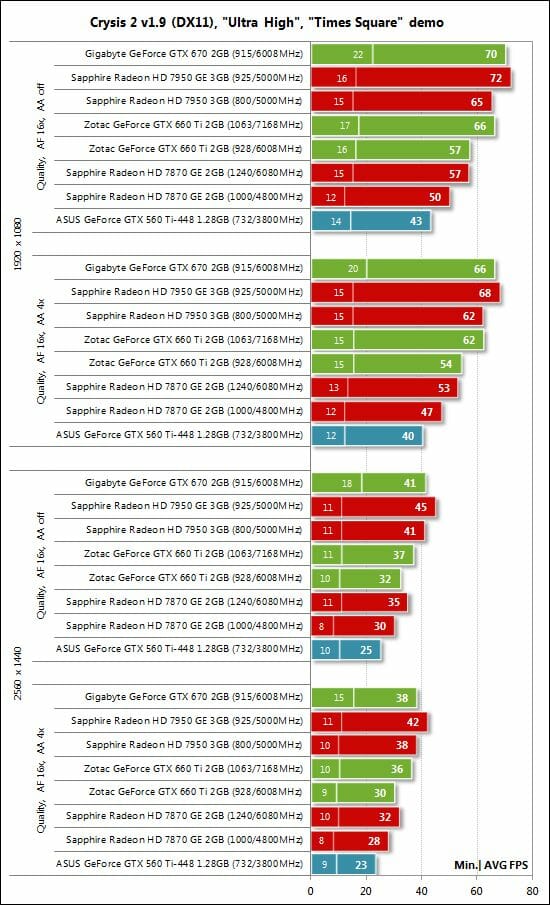
Crysis 2 proves the superiority of the GeForce GTX 660 Ti over the Radeon HD 7870 GHz Edition, yet the new card finds it difficult to compete with the Radeon HD 7950, especially if the latter has the updated BIOS. Compared to the GTX 560 Ti-448 and GTX 670, the GeForce 660 Ti performs just like in the previous tests.
Hard Reset Demo
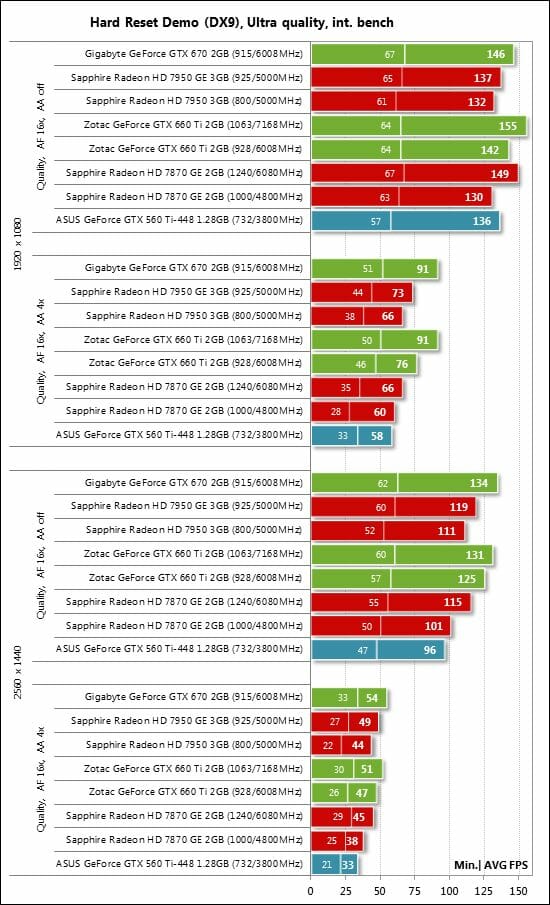
The GeForce GTX 660 Ti is ahead of both Radeons in Hard Reset and equals the accelerated version of Radeon HD 7950.
Batman: Arkham City
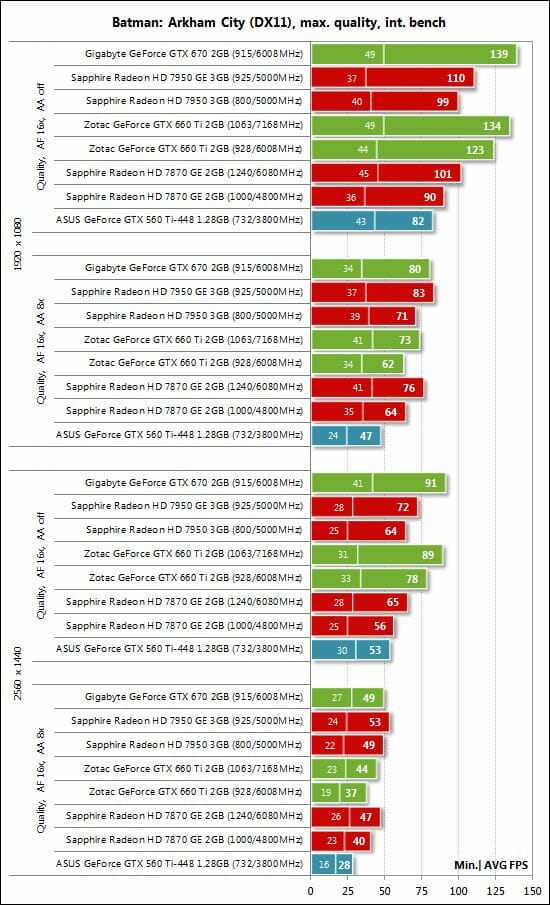
Batman: Arkham City exposes the weakness of the GeForce GTX 660 Ti in the way of its narrow memory bus. When there’s no antialiasing, the new card is ahead of the Radeon HD 7870 GHz Edition and both Radeon HD 7950s. But as soon as we turn on 8x MSAA, the GTX 660 Ti slows down, falling behind the two Radeons. Thus, we have to admit that the reduced memory bus of the new GeForce does show up in some situations.
Battlefield 3
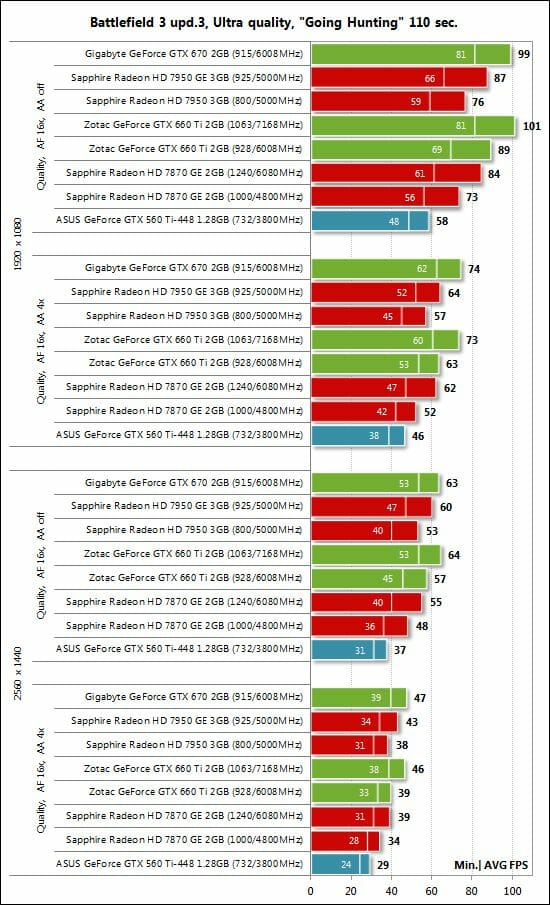
The GeForce GTX 660 Ti scores another win over its AMD opponents in the highly popular Battlefield 3. It is only with the new BIOS that the Radeon HD 7950 can deliver the same performance. The overclocked GTX 660 Ti can match the more expensive GeForce GTX 670.
DiRT Showdown
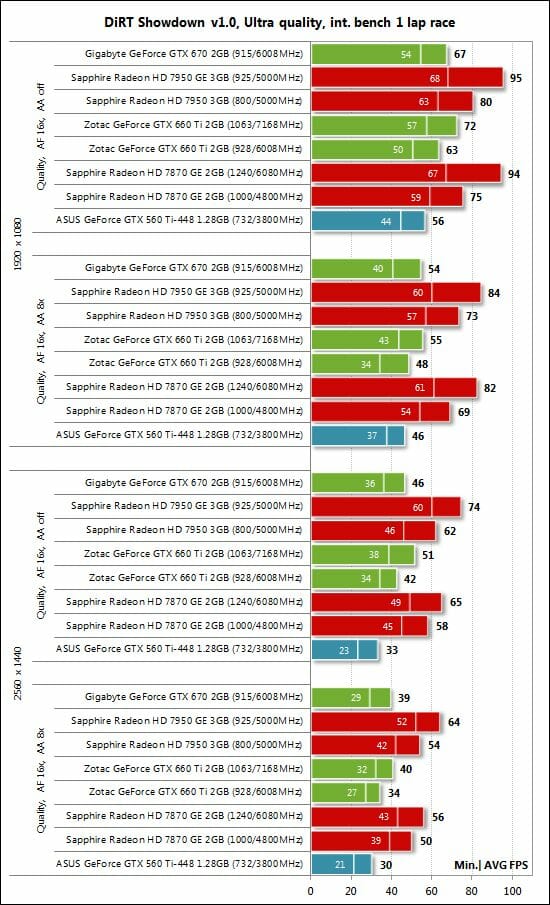
This looks like the best win for AMD in this test session. Nvidia is uncompetitive here.
Sniper Elite V2 Benchmark
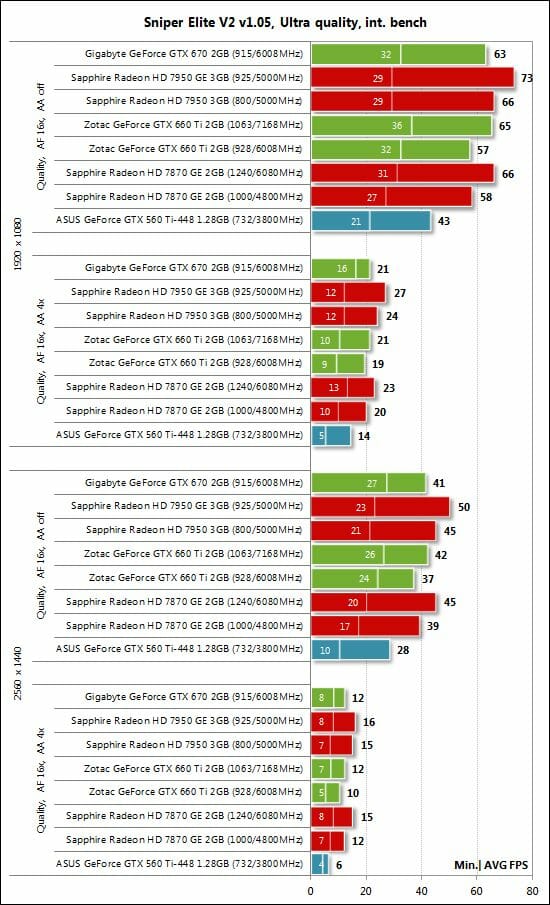
And here’s another win for AMD. Anyway, we can note that the overclocked GeForce GTX 660 Ti delivers the same performance as the GeForce GTX 670.
Performance Summary
First of all, let’s see how much faster the new GeForce GTX 660 Ti is compared to the previous-generation mainstream card GeForce GTX 560 Ti 448 Cores. Of course, it would have been better to take an ordinary GTX 660 Ti (the 448 Cores version is closer to the GTX 570) but we didn’t have one at hand. Anyway, here are the results.
So the GTX 660 Ti is an average 31-35% faster at 1920×1080 and 38-44% faster at 2560×1440. The maximum gap (over 100%) can be observed in Metro 2033 at certain settings, yet the new card also enjoys a huge advantage in such games as Total War: Shogun 2, Battlefield 3, Batman: Arkham City, Lost Planet 2 and S.T.A.L.K.E.R.: Call of Pripyat, and also in 3DMark 2011. Take note of the fact that the GeForce GTX 660 Ti enjoys a larger advantage over the GeForce GTX 560 Ti 448 Cores with antialiasing turned off rather than on. It is easy to explain. The fast GPU of the newer card is just limited by its 192-bit memory bus whereas the GeForce GTX 560 Ti 448 Cores, on the contrary, has a slower GPU but its 320-bit bus is better suited for heavier graphics loads.
The next pair of diagrams compares the GeForce GTX 670 with the GTX 660 Ti. Let’s see the gap between the new product and its higher-class cousin.
The gap is actually not very large. The GTX 660 Ti is an average 13-19% slower than the GTX 670 at 1920×1080 and 15-23% slower at 2560×1440. That’s not much considering that the GTX 670 costs 33% more. The effect of the narrow bus can be seen again, by the way: the gap is wider when antialiasing is turned on.
Now let’s see if this gap can be bridged by overclocking the GeForce GTX 660 Ti to 1063/7168 MHz.
Indeed, the two cards are comparable now except in Sid Meier’s Civilization V where the GTX 670 still enjoys a large advantage. So, if you’re into overclocking, you may want to buy a new GTX 660 Ti (after its price stabilizes) instead of a GTX 670.
Now that we know the position of the GeForce GTX 660 Ti in Nvidia’s product line-up, let’s check out its standing relative to AMD solutions. First goes the Radeon HD 7870 GHz Edition which has the same recommended price as the GeForce GTX 660 Ti.
They are identical in price but not in performance. The Radeon HD 7870 GHz Edition wins in DiRT Showdown, Sniper Elite V2 and (at the heavier settings) in Metro 2033: The Last Refuge, Aliens vs. Predator (2010), Sid Meier’s Civilization V and Batman: Arkham City. But the rest of the games and benchmarks are won by the GeForce GTX 660 Ti. The latter is an average 12-17% faster at 1920×1080 and 6-13% faster at 2560×1440. That’s good but only if the GTX 660 Ti costs as much as the Radeon HD 7870 GHz Edition costs now.
Because if the GeForce GTX 660 Ti hits the market at a higher retail price, it will have to compete with the Radeon HD 7950 with the following outcome.
The Radeon HD 7950 improves AMD’s position even more in the games where the Radeon HD 7870 GHz Edition was superior and adds a win in Crysis 2 to that. The other tests are still won by the GeForce GTX 660 Ti, but by a smaller margin. Mathematically, the Radeon HD 7950 is faster than the GeForce GTX 660 Ti across all the tests (by -2 to +6% at 1920×1080 and by 5 to 14% at 2560×1440).
As we wrote in the test methods section, AMD has prepared to meet the GeForce GTX 660 Ti release by updating the Radeon HD 7950’s BIOS and increasing the latter’s GPU clock rate by 125 MHz. With the new BIOS the Radeon HD 7950 is clearly better than the GeForce GTX 660 Ti.
Well, the last pair of diagrams is too provocative to comment upon. The GeForce GTX 660 Ti overclocks well, too, and the Radeon HD 7950 itself can easily reach higher clock rates than those of the new BIOS.
Conclusion
However trivial it may sound, the success of the Nvidia GeForce GTX 660 Ti will depend on its pricing. Frankly speaking, it’s hard to understand, like with the reference GeForce GTX 670, why these small graphics cards (only 170 millimeters long) cost as much as $299 and $399 to manufacture. Anyway, Nvidia thinks such pricing competitive. Time will show if this is a correct decision but AMD has already successfully responded with its accelerated Radeon HD 7950. And if the GeForce GTX 660 Ti comes to be priced comparably to the Radeon HD 7870 GHz Edition (which we doubt), the latter is likely to get cheaper (as AMD has more time and capacity for price maneuvering) and, eventually, cause the GTX 660 Ti to get cheaper too. Anyway, customers are going to be the winning side in every scenario. We only warn you against buying a GTX 660 Ti in its first weeks on the market because the price will hardly be adequate. Moreover, there’s a host of pre-overclocked GeForce GTX 660 Ti cards ready to come out, so you’ll have a wider choice very soon.
Talking about the particular product, the Zotac GeForce GTX 660 Ti 2GB is a compact and well-made graphics card with an original cooler that is sufficiently efficient (for this product class) and moderately noisy. Our sample turned out to have good overclocking potential (+14.5% and +19.3% in terms of the GPU and memory clock rate, respectively) which helped us make it almost as fast as the more expensive GeForce GTX 670. Being one of the first GeForce GTX 660 Ti cards available, it comes in an informative and reliable packaging, with numerous accessories and two games (one of which is the newest Borderlands 2), and features a 3-year warranty. Its price is the only factor we may find fault with, but we’ve already mentioned that above.